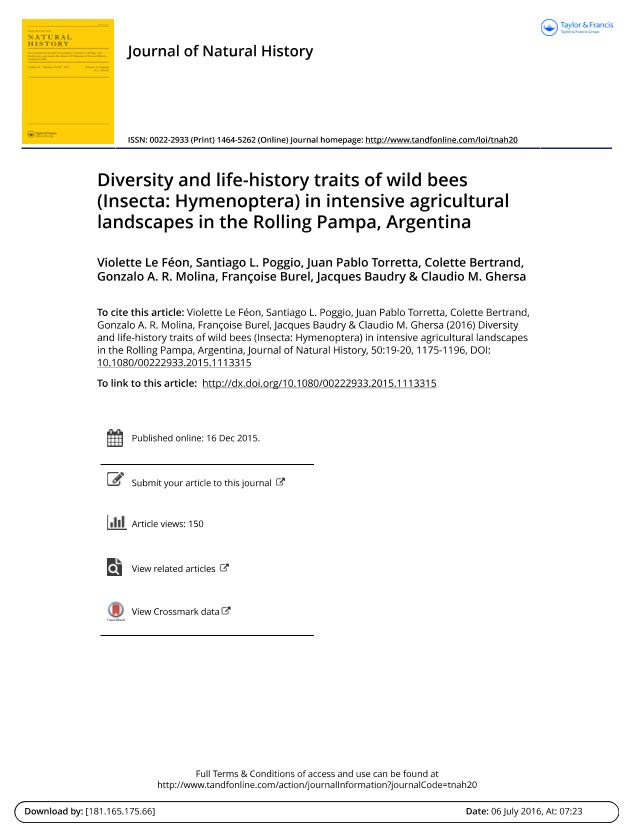Artículo
Diversity and life-history traits of wild bees (Insecta: Hymenoptera) in intensive agricultural landscapes in the Rolling Pampa, Argentina
Le Féon, Violette; Poggio, Santiago Luis ; Torretta, Juan Pablo
; Torretta, Juan Pablo ; Bertrand, Colette; Molina, Gonzalo Alberto Roman
; Bertrand, Colette; Molina, Gonzalo Alberto Roman ; Burel, Françoise; Baudry, Jacques; Ghersa, Claudio Marco
; Burel, Françoise; Baudry, Jacques; Ghersa, Claudio Marco
 ; Torretta, Juan Pablo
; Torretta, Juan Pablo ; Bertrand, Colette; Molina, Gonzalo Alberto Roman
; Bertrand, Colette; Molina, Gonzalo Alberto Roman ; Burel, Françoise; Baudry, Jacques; Ghersa, Claudio Marco
; Burel, Françoise; Baudry, Jacques; Ghersa, Claudio Marco
Fecha de publicación:
12/2016
Editorial:
Taylor & Francis Ltd
Revista:
Journal of Natural History
ISSN:
0022-2933
e-ISSN:
1464-5262
Idioma:
Inglés
Tipo de recurso:
Artículo publicado
Clasificación temática:
Resumen
The decline of bees is a major concern due to their vital role inpollinating many crops and wild plants. Some regions in SouthAmerica, and especially the Pampas, are amongst those parts ofthe world where stressors of bee populations have been littlestudied. The Pampas has been intensively transformed for agriculture,being presently one of the most productive areas of agriculturalcommodities in the world. Here, we aim to provide firstinsights on the taxonomic and functional composition of beeassemblages in the Rolling Pampa, the most intensively managedpart of the Pampas. Soybean (herbicide-tolerant genetically modifiedvarieties) is the predominant crop in this region. Bees weresampled with coloured pan traps. Sampling points were locatedon field margins in either the cropped or the semi-natural grasslandarea of a farmland site devoted to annual cropping. A total of2384 individuals were caught, representing 33 taxa [mainly (morpho)species]. The subgenus Lasioglossum (Dialictus) largely dominatedcaptures (78% of the total abundance) and was relativelyabundant in the entire study area, suggesting that some speciesare likely to reach their ecological requirements in cropped areas.No-till fields and field margins may provide large areas for thesebelow-ground nesting species, while their polylectic food preferencesallow them to collect pollen on a wide range of plantspecies, among them possibly soybean. On the contrary, the richnessand the abundance of other taxa were higher in the seminaturalarea than in the cropped area. Among them, abovegroundnesting or oil-collecting species, which have more specialisednesting and floral requirements, were highly associated withthe semi-natural area. Our findings highlight the large dominanceof L. (Dialictus) species in this highly intensively managed landscape,and the urgent need of preserving semi-natural habitats tomaintain species-rich and functionally diverse bee communities inthe Pampas.
Archivos asociados
Licencia
Identificadores
Colecciones
Articulos(IFEVA)
Articulos de INST.D/INV.FISIOLOGICAS Y ECO.VINCULADAS A L/AGRIC
Articulos de INST.D/INV.FISIOLOGICAS Y ECO.VINCULADAS A L/AGRIC
Articulos(OCA PQUE. CENTENARIO)
Articulos de OFICINA DE COORDINACION ADMINISTRATIVA PQUE. CENTENARIO
Articulos de OFICINA DE COORDINACION ADMINISTRATIVA PQUE. CENTENARIO
Citación
Le Féon, Violette; Poggio, Santiago Luis; Torretta, Juan Pablo; Bertrand, Colette; Molina, Gonzalo Alberto Roman; et al.; Diversity and life-history traits of wild bees (Insecta: Hymenoptera) in intensive agricultural landscapes in the Rolling Pampa, Argentina; Taylor & Francis Ltd; Journal of Natural History; 50; 19-20; 12-2016; 1175-1196
Compartir
Altmétricas



